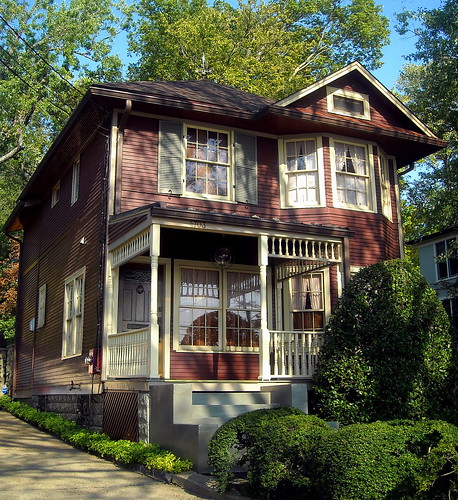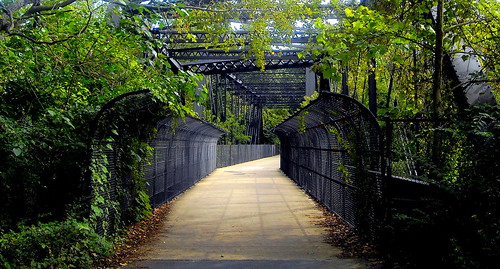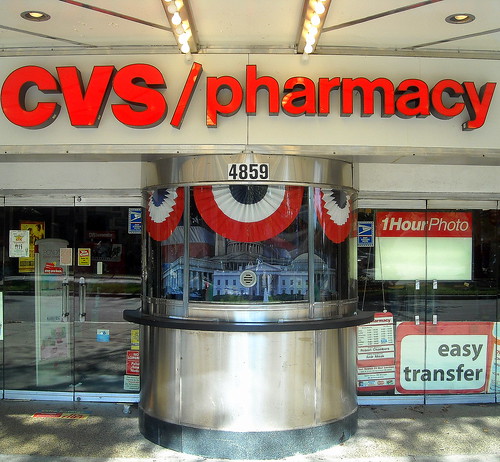
‘dream house, pt. 4’
courtesy of ‘NCinDC’
Welcome to the last Where We Live of 2009! It’s been a fun year exploring DC’s neighborhoods, and to close out the year I wanted to profile one of the lesser-known neighborhoods in the city: the Palisades. This neighborhood is beautiful and scenic and has a real sense of community, but because there’s not great transit to the area it is a bit cut off from the rest of the city. And since it is lesser-known, here’s where it is: it runs along the Potomac River, from the western edge of Georgetown University all the way to the Maryland border. Read on to see why it’s worth a trip out there!
History: This is another neighborhood that was developed on a streetcar line. The area was laid out in 1893 by the Palisades Improvement Company, and was developed as a streetcar suburb on the line that connected Georgetown and Glen Echo. The residential character of the area grew, and by the twentieth century the area was being developed with large homes and estates. The streetcar line was shut down in 1961, but the prominence of the area grew. The post-war era attracted developers to fill the area with subdivisions and large homes, and today the Palisades is a mix of houses from many different eras.
Neighborhood Character: The Palisades is known for its tree-lined streets and small-town character. The area is predominately residential, but MacArthur Boulevard is the neighborhood’s commercial strip. It is lined with restaurants and shops, and it’s very walkable. This part of the city really doesn’t look like it’s part of a city at all– it really feels like a small town tucked away in a beautiful natural area. The people who live in this area don’t necessarily look like many other DC residents either: the Palisades is home to an overwhelmingly white and affluent population, with a lot more families with young children than you’d see in other neighborhoods.

‘Crescent Trail bridge’
courtesy of ‘NCinDC’
Transportation: As I mentioned earlier, this area isn’t very transit accessible. It itself is a walkable neighborhood, but to get anywhere outside the neighborhood you’ll probably need a car. There are some options for buses in the area though: the D6 connects the area with downtown to Stadium-Armory, and the N6 connects via Massachusetts Avenue. No Zipcars to speak of, or bike sharing stations yet– but it’s a great area to walk or bike. The Capital Crescent Trail and the C&O Towpath (some of the area’s best bike routes) are great biking or running trails, and via bike this neighborhood is just a few minutes away from Georgetown and downtown DC.

‘Fletcher’s Boathouse-5’
courtesy of ‘TrailVoice’
What to See: You’d think that for being a residential-dominated neighborhood with little transit access, there wouldn’t be that much to see or do in this area. You’d be wrong! Check these options out:
- Take advantage of the natural setting. Head to Fletcher’s Cove to rent a kayak or canoe, or go fishing in the Potomac River. You can even rent a bike at Fletcher’s Cove to explore the Capital Crescent Trail.
- Do something cultural. You can check out antiques at Capital Antiques, or find some art to decorate your home at the neighborhood’s American Painting art gallery.
- Time to eat? You’ve got lots of options for great food in this neighborhood. Check out Figs for Middle Eastern food, Palisades Pizzeria for pizza or clams, or Et Voila! for great Belgian food.
- Just walk around the neighborhood and take in the beautiful architecture. Don’t miss the converted MacArthur Theater, which was showing movies from 1946 to 1997. It’s now a CVS, but a very cool looking CVS (see below).
Neighborhood Links: I may have come down hard on Cleveland Park for not having any bloggers, but at least that neighborhood has an online presence! The Palisades doesn’t have any bloggers or any websites about the neighborhood except for the local citizens’ association. The Palisades Citizens’ Association is an active group that publishes a monthly newsletter and organizes community events, like the 4th of July community parade (you’ve really gotta check it out one year!). But other than that, there’s just not much out there about the Palisades on the interwebs.
What’s Nearby: The Palisades is northwest of Georgetown and west of Glover Park.

‘2 for the 9:00 show, please’
courtesy of ‘NCinDC’
Why We Love The Palisades: There are plenty of neighborhoods in DC with tree-lined streets and beautiful rowhouses, but Palisades is just spectacular. The houses are huge, the views are gorgeous, and because it’s removed from the hustle and bustle of downtown it really feels like a small town. The proximity to nature is fantastic, and it’s hard to believe you’re still in the city when you’re walking around this area. For those who value peace and quiet, and who want a small-town feel while still living in the city, Palisades is the place for you (good luck affording it).
Just to put in a reiteration of how lovely Et Voila! is – I have a special place in my heart for their quiche, fries and mussels. Mmm… love Et Voila!
I’m sure the demographics of this neighborhood read very homogeneous: rich, lacking in racial/ethnic diversity. Like Spring Valley, this area doesn’t even figure into the possibilities of most DC residents.
As a Hispanic of modest income that lives in the Palisades, I’ll let City Girl DC’s comment slide.
Complete disconnect when you read a comment like that and then go and look at the author’s blog.
Shannon,
Another good article on an interesting neighborhood. I noticed you didn’t point out the racial demographics of other neighborhoods you’ve previously profiled (e.g. Petworth). Just curious, was this deliberate?
When the neighborhood is known for certain demographics, I do try to mention that (see River East, Georgetown) but you’re right that it is not consistent across all Where We Lives. I thought it was worth mentioning here because I knew NOTHING about this neighborhood until I happened across it a year ago, and I think that families/affluence/lots of white people (though as Bilsko shows, not all) are somewhat accurate descriptions of this neighborhood.
As already mentioned in the article, I’d like to stress again one of the less known values of Palisades is it’s proximity to the capitol crescent trail – and the speed and ease it provides to cyclists who want to make a quick ride into Georgetown or Foggy Bottom. In less than 10 minutes I can get from Arizona ave to the Patagonia store on Wisconsin – and that’s a relatively flat bike ride too. Also, while FIGS is mentioned, next door is the great cheap eats of Kotobuki sushi.
+1 on Jan’s comment – the Capital Crescent is a major plus for Palisades residents. I use the CCT every day to ride into work. It sure would be nice if there were one more access point between the Canal Rd. tunnel and the Macomb St. stairs. (The boat house at the intersection of Reservoir and Canal is another one, but it can be tricky to get across Canal at rush hour.
Oh and +1 on Kotobuki – and also Blacksalt for Sunday brunch (its no more expensive than any other comparable Sunday brunch in town, even though the restaurant is normally really pricey.)
Pingback: uberVU - social comments